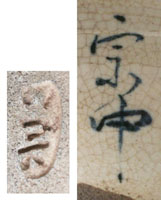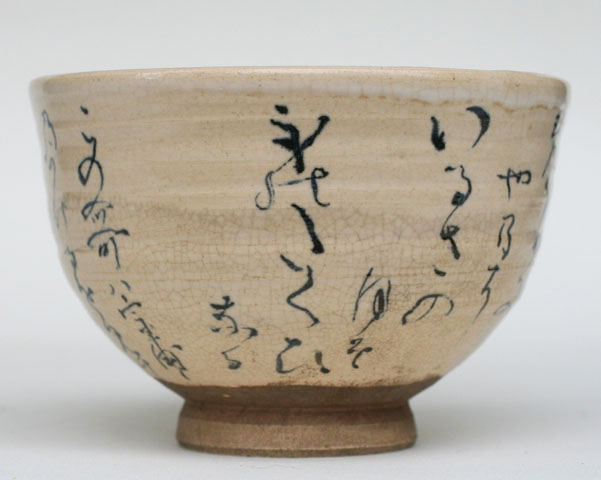Kyoyaki
Chawan, tea bowl - Chinese PoemSigned: Sôchû
Seals: Dôhachi
Technique: Kyoyaki, stoneware from Kyoto from the Awataguchi (Awata kiln) with a calligraphy in iron oxide under fine crackled cream and white dripping glaze. Ø 11,5 x 7,8
Box: authorized by a later generation Dôhachi
Condition: fine, except for a small nick to the glaze at the rim
Poem unread.
Authorized by a later generation Dôhachi.
A rare and important bowl in the world of tea as well as the world of Japanese pottery.
Sôchû was the 8th iemoto (family head) of the Enshû style of tea established by Kobori Enshû. He was born into the family of the 6th generation iemoto. He was one of the most famous of the late Edo chajin, and helped to resurrect the family name after the backlash against traditional Japanese tea in the Bakumatsu Era (1853-1867).
Reference:
Sasaki Sanmi p. 723
Dôhachi is often referred to as Dôhachi I. However, because his father was likewise active as a potter under that name we also find him designated Dôhachi II. Dôhachi was active in Kyoto, where he had kilns at the Nishi Honganji and in the Saga district. He also worked in Takamatsu on the island of Shikoku. Dôhachi studied with Okuda Eisen (1753-1811). Dôhachi is associated with cha no yu. From 1806 he was permitted to conduct official business with the prince-abbot of the Shoren-in temple, which secured his reputation. Along with Aoki Mokubei (1767-1833) and Eiraku Hozen (1795-1854) he is considered one of the great masters of Kyoto pottery of the late Tokugawa period.
Reference:
Roberts p. 18
Jenyns 1971 p. 246-247
Jenyns 1965 p. 295-297
Price: ON REQUEST

